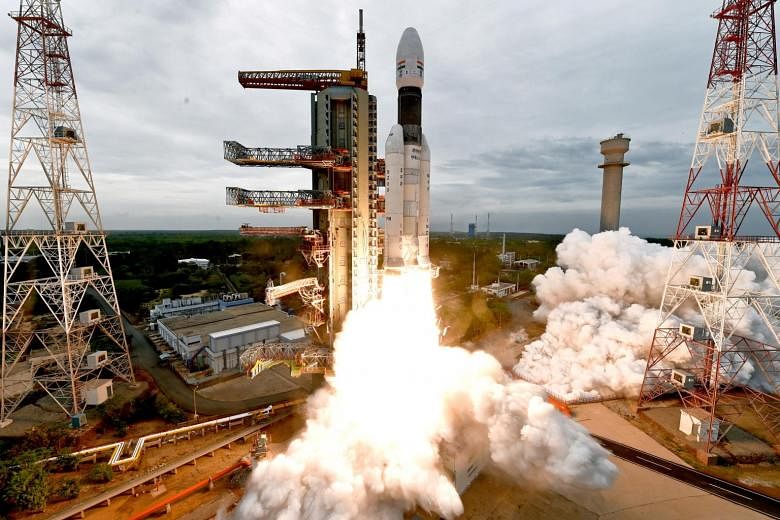India has successfully launched its mission to explore the south pole of the Moon, in the most complex space mission by a country keen to maintain a place at the forefront of space exploration.
The rocket carrying spacecraft Chandrayaan-2 blasted off from the Indian Space Research Organisation (ISRO) space station in Sriharikota, off the coast of Andhra Pradesh state, at 2.43am local time (5.13am Singapore time) yesterday.
"It is the beginning of a historical journey of India to the Moon and to land at a place near the south pole to carry out scientific experiments to explore the unexplored," said ISRO chairman K. Sivan.
It was the second attempt at take-off after the first one on Monday last week was called off due to a technical snag.
Prime Minister Narendra Modi tweeted: "The launch of #Chandrayaan-2 illustrates the prowess of our scientists and the determination of 130 crore (1.3 billion) Indians to scale new frontiers of science. Every Indian is immensely proud today!"
If India succeeds in landing on the Moon and sending out a rover, it will be the fourth country to do so, after the United States, Russia and China.
This is India's second mission to the Moon. The first mission, Chandrayaan-1, was launched in October 2008. It did not land on the Moon but searched for water using radar.
While yesterday's launch went off as planned, the bigger challenge is to guide Chandrayaan-2 into the orbit of the Moon and navigate a controlled landing of the lander on the surface of the Moon.
The rover will then be sent out to study the surface and search for water in a mission that costs 10 billion rupees (S$195 million).
"The next 54 days are crucial. It will have to travel from the Earth's orbit to the Moon's orbit," said Professor Ajey Lele, a senior fellow at the Institute for Defence Studies and Analyses.
Maintaining communication between the lander, rover and orbiter will also be a challenge.
"After landing, the rover will get out and can communicate only with the lander, which (in turn) can communicate only with the orbiter, which will send communication to a deep space network in Bangalore," said Prof Lele.
India has built up its space programme indigenously over the past few decades. It has emerged as the leader in low-cost satellite launches, sending dozens of foreign satellites, including eight satellites from Singapore, into space.
The space programme, which was earlier geared towards improving satellite communications and remote sensing applications, such as weather forecasting and disaster management, has in recent years increasingly branched into space exploration.
In May 2014, India launched the Mars Orbiter, becoming the first Asian nation to reach the planet after China failed to do so. The orbiter cost around US$70 million (S$95 million), compared with Nasa's US$671 million Maven mission.
In April this year, India shot down a live satellite in space, becoming the fourth country with such capabilities. It plans to launch a manned mission to space by 2022.
Much is riding on the Moon mission, noted space scientists.
"It is a very critical milestone in India's space programme. It represents a high level of complexities," said Dr K. Kasturirangan, a former ISRO chairman.
India's long-term goal in space exploration requires "basic capabilities like calculating trajectory, interplanetary flights, precise control guidance and navigation", he said, adding that the mission is the first important step towards that goal.
Science journalist Pallava Bagla noted "the stakes are very high", adding that the capabilities for the Moon mission are also needed to send humans into space.
"If colonies have to be set up outside the Earth's orbit, India should not be left behind."


